Factors Influencing Temperature Measurements from Miniaturized Thermal Infrared (TIR) Cameras: A Laboratory-Based Approach
Abstract
:1. Introduction
1.1. Context and Background
1.2. Practices for Deriving Temperature Data in Field Situations
1.3. Research Objectives
2. Materials and Methods
2.1. Materials
2.2. Experimental Set-Up of Laboratory Experiments
2.2.1. General Description
2.2.2. Stabilization Time
2.2.3. Sensor Temperature
2.2.4. Sensor–Object Distance
2.2.5. Wind and Heating Effects
2.2.6. Data Analysis
3. Results
3.1. Measured Temperature’s Stability over Time
3.2. Response to Ambient Temperature Adjustments
3.3. The Effect of Measuring Distance on the Measured Temperature
3.4. Wind and Heating Up Effects on Camera’s Response
4. Discussion
- A larger extent of temperature shifts has been witnessed directly after activation. We suggest allowing a longer time for UAV-mounted cameras to stabilize after activation, preferably at least one hour. For handheld devices, a stabilization period of 30–40 min is enough. Other studies suggest 30–60 min to stabilize whether or not the same abrupt changes have been observed in the beginning [22,34,43]. There is a trade-off between the duration of the stabilization period and the length of the UAV flight.
- For cameras of which the automatic corrections are executed periodically, there is a trade-off between ensuring the data consistency and diminishing temperature drifts in flight campaigns. If the former is chosen, then longer-period NUCs will make a larger sequence of collected imagery comparable to each other upon using drift correction methods. Otherwise, image mosaic will be a major problem with the choice of frequent NUCs. For UAV-based cameras, we are inclined to still suggest high-frequency NUCs if the acquired TIR imagery is applied to quantitative applications. It is best to perform NUCs with the smallest feasible time interval one can choose from the camera settings. For handheld cameras, it would be better to always capture images shortly after manual or automated NUCs to avoid drifts.
- In the laboratory experiment, following factors contributed to the accuracy changes in distance tests: (a) noise as a result of radiation from other objects in the room; (b) water vapor absorption (this study had very high humidity settings); (c) size of the blackbody. For all miniaturized TIR cameras, the temperature measurements are underestimated to a larger extent as the measuring distance increases. Tests on different flight heights before actual flight campaigns can provide insight into the influence of atmospheric interference in the fields. Based on the test results, the researcher can prepare formal experiments with the corresponding influence degree in mind. Afterwards, suitable atmospheric correction models could be used to effectively reduce the deviation of observation values caused by atmospheric interference as an option.
- The measured temperature is highly correlated with the sensor temperature’s variations. Thus, real-time observations of the sensor temperature (or FPA temperature) are preferred in flight campaigns if applicable for specific camera models (e.g., FLIR Tau 2). This can contribute to the calibration of measured temperature in the post-processing procedure.
- Large fluctuations in camera signal have been found during the treatments of testing wind and heating on camera performance. Cameras can be shaded during flights to diminish this disturbance.
- Previous studies concluded that it is not feasible to directly translate the laboratory calibration methods into field tests as the uncertainty expands to a much larger extent. However, as this study has demonstrated, a laboratory-based simulation approach quantifies the inaccuracy in measured temperature brought by varying influencing factors, which can guide field experimental set-ups. It still needs to be explored how the problems found in temperature measurements can be avoided in an operational context where all influencing factors add up by continuing follow-up field tests.
5. Conclusions
Supplementary Materials
Author Contributions
Funding
Institutional Review Board Statement
Informed Consent Statement
Data Availability Statement
Acknowledgments
Conflicts of Interest
References
- Baker, E.A.; Lautz, L.K.; McKenzie, J.M.; Aubry-Wake, C. Improving the accuracy of time-lapse thermal infrared imaging for hydrologic applications. J. Hydrol. 2019, 571, 60–70. [Google Scholar] [CrossRef]
- Ottlé, C.; Vidal-Madjar, D.; Girard, G. Remote sensing applications to hydrological modeling. J. Hydrol. 1989, 105, 369–384. [Google Scholar] [CrossRef]
- Anderson, M.C.; Allen, R.G.; Morse, A.; Kustas, W.P. Use of Landsat thermal imagery in monitoring evapotranspiration and managing water resources. Remote Sens. Environ. 2012, 122, 50–65. [Google Scholar] [CrossRef]
- Ahmadirouhani, R.; Karimpour, M.-H.; Rahimi, B.; Malekzadeh-Shafaroudi, A.; Pour, A.B.; Pradhan, B. Integration of SPOT-5 and ASTER satellite data for structural tracing and hydrothermal alteration mineral mapping: Implications for Cu–Au prospecting. Int. J. Image Data Fusion 2018, 9, 237–262. [Google Scholar] [CrossRef]
- Vaughan, R.G.; Hook, S.J.; Calvin, W.M.; Taranik, J.V. Surface mineral mapping at Steamboat Springs, Nevada, USA, with multi-wavelength thermal infrared images. Remote Sens. Environ. 2005, 99, 140–158. [Google Scholar] [CrossRef]
- Keramitsoglou, I.; Daglis, I.A.; Amiridis, V.; Chrysoulakis, N.; Ceriola, G.; Manunta, P.; Maiheu, B.; De Ridder, K.; Lauwaet, D.; Paganini, M. Evaluation of satellite-derived products for the characterization of the urban thermal environment. J. Appl. Remote Sens. 2012, 6, 061704. [Google Scholar] [CrossRef]
- Hua, L.; Shao, G. The progress of operational forest fire monitoring with infrared remote sensing. J. For. Res. 2017, 28, 215–229. [Google Scholar] [CrossRef]
- Aubrecht, D.M.; Helliker, B.R.; Goulden, M.; Roberts, D.A.; Still, C.J.; Richardson, A.D. Continuous, long-term, high-frequency thermal imaging of vegetation: Uncertainties and recommended best practices. Agric. For. Meteorol. 2016, 228-229, 315–326. [Google Scholar] [CrossRef] [Green Version]
- Berni, J.A.J.; Zarco-Tejada, P.J.; Suarez, L.; Fereres, E. Thermal and Narrowband Multispectral Remote Sensing for Vegetation Monitoring from an Unmanned Aerial Vehicle. IEEE Trans. Geosci. Remote Sens. 2009, 47, 722–738. [Google Scholar] [CrossRef] [Green Version]
- Messina, G.; Modica, G. Applications of UAV Thermal Imagery in Precision Agriculture: State of the Art and Future Research Outlook. Remote Sens. 2020, 12, 1491. [Google Scholar] [CrossRef]
- Gallo, M.A.; Willits, D.S.; Lubke, R.A.; Thiede, E.C. Low-cost uncooled IR sensor for battlefield surveillance. In Infrared Technology XIX; Andersen, B.F., Shepherd, F.D., Eds.; SPIE: Bellingham, WA, USA, 1993; Volume 2020, pp. 351–362. [Google Scholar]
- Sharma, J.B. Applications of Small Unmanned Aircraft Systems: Best Practices and Case Studies; CRC Press: Boca Raton, FL, USA, 2019. [Google Scholar]
- Sheng, H.; Chao, H.; Coopmans, C.; Han, J.; McKee, M.; Chen, Y. Low-cost UAV-based thermal infrared remote sensing: Platform, calibration and applications. In Proceedings of the 2010 IEEE/ASME International Conference on Mechatronic and Embedded Systems and Applications, QingDao, China, 15–17 July 2010; pp. 38–43. [Google Scholar]
- Jensen, A.M.; McKee, M.; Chen, Y. Procedures for processing thermal images using low-cost microbolometer cameras for small unmanned aerial systems. In Proceedings of the 2014 IEEE Geoscience and Remote Sensing Symposium (IGARSS), Quebec City, QC, Canada, 13–18 July 2014; pp. 2629–2632. [Google Scholar]
- Martínez, J.; Egea, G.; Agüera, J.; Pérez-Ruiz, M. A cost-effective canopy temperature measurement system for precision agriculture: A case study on sugar beet. Precis. Agric. 2016, 18, 95–110. [Google Scholar] [CrossRef]
- Zhang, L.; Niu, Y.; Zhang, H.; Han, W.; Li, G.; Tang, J.; Peng, X. Maize Canopy Temperature Extracted from UAV Thermal and RGB Imagery and Its Application in Water Stress Monitoring. Front. Plant Sci. 2019, 10, 1270. [Google Scholar] [CrossRef] [PubMed]
- Crusiol, L.G.T.; Nanni, M.R.; Furlanetto, R.H.; Sibaldelli, R.N.R.; Cezar, E.; Mertz-Henning, L.M.; Nepomuceno, A.L.; Neumaier, N.; Farias, J.R.B. UAV-based thermal imaging in the assessment of water status of soybean plants. Int. J. Remote Sens. 2019, 41, 3243–3265. [Google Scholar] [CrossRef]
- Tattaris, M.; Reynolds, M.P.; Chapman, S. A direct comparison of remote sensing approaches for high-throughput phenotyping in plant breeding. Front. Plant Sci. 2016, 7, 1131. [Google Scholar] [CrossRef] [PubMed]
- Bellvert, J.; Zarco-Tejada, P.J.; Girona, J.; Fereres, E. Mapping crop water stress index in a ‘Pinot-noir’ vineyard: Comparing ground measurements with thermal remote sensing imagery from an unmanned aerial vehicle. Precis. Agric. 2014, 15, 361–376. [Google Scholar] [CrossRef]
- García-Tejero, I.; Hernández, A.; Padilla-Díaz, C.; Diaz-Espejo, A.; Fernández, J. Assessing plant water status in a hedgerow olive orchard from thermography at plant level. Agric. Water Manag. 2017, 188, 50–60. [Google Scholar] [CrossRef] [Green Version]
- Gerhards, M.; Rock, G.; Schlerf, M.; Udelhoven, T. Water stress detection in potato plants using leaf temperature, emissivity, and reflectance. Int. J. Appl. Earth Obs. Geoinf. 2016, 53, 27–39. [Google Scholar] [CrossRef]
- Padhi, J.; Misra, R.; Payero, J. Estimation of soil water deficit in an irrigated cotton field with infrared thermography. Field Crop. Res. 2012, 126, 45–55. [Google Scholar] [CrossRef] [Green Version]
- Ju, S.-B.; Yong, Y.-J.; Kim, S.-G. Design and fabrication of a high-fill-factor microbolometer using double sacrificial layers. In Infrared Technology and Applications XXV; Andresen, B.F., Strojnik, M., Eds.; SPIE: Bellingham, WA, USA, 1999; Volume 3698, pp. 180–189. [Google Scholar]
- Yu, L.; Guo, Y.; Zhu, H.; Luo, M.; Han, P.; Ji, X. Low-Cost Microbolometer Type Infrared Detectors. Micromachines 2020, 11, 800. [Google Scholar] [CrossRef]
- Lijing, Y.; Libin, T.; Wenyun, Y.; Qun, H. Research progress of uncooled infrared detectors. Infrared Laser Eng. 2021, 50, 20211013. [Google Scholar] [CrossRef]
- Sizov, F. IR region challenges: Photon or thermal detectors? Outlook and means. Semicond. Phys. Quantum Electron. Optoelectron. 2012, 15, 193–199. [Google Scholar] [CrossRef] [Green Version]
- Rogalski, A. Recent progress in infrared detector technologies. Infrared Phys. Technol. 2011, 54, 136–154. [Google Scholar] [CrossRef]
- Mesas-Carrascosa, F.-J.; Pérez-Porras, F.; De Larriva, J.E.M.; Frau, C.M.; Agüera-Vega, F.; Carvajal-Ramírez, F.; Martínez-Carricondo, P.; García-Ferrer, A. Drift Correction of Lightweight Microbolometer Thermal Sensors On-Board Unmanned Aerial Vehicles. Remote Sens. 2018, 10, 615. [Google Scholar] [CrossRef] [Green Version]
- Deane, S.; Avdelidis, N.P.; Ibarra-Castanedo, C.; Zhang, H.; Nezhad, H.Y.; Williamson, A.A.; Mackley, T.; Maldague, X.; Tsourdos, A.; Nooralishahi, P. Comparison of cooled and uncooled ir sensors by means of signal-to-noise ratio for ndt diagnostics of aerospace grade composites. Sensors 2020, 20, 3381. [Google Scholar] [CrossRef] [PubMed]
- Olbrycht, R.; Więcek, B.; De Mey, G. Thermal drift compensation method for microbolometer thermal cameras. Appl. Opt. 2012, 51, 1788–1794. [Google Scholar] [CrossRef]
- Aragon, B.; Johansen, K.; Parkes, S.; Malbeteau, Y.; Al-Mashharawi, S.; Al-Amoudi, T.; Andrade, C.F.; Turner, D.; Lucieer, A.; McCabe, M.F. A calibration procedure for field and UAV-based uncooled thermal infrared instruments. Sensors 2020, 20, 3316. [Google Scholar] [CrossRef]
- Chen, X.; Liu, B.; Fang, C.; Lv, Q. Microbolometer parameters optimization for high-performance focal plane array. Optik 2021, 240, 166910. [Google Scholar] [CrossRef]
- Acorsi, M.; Gimenez, L.; Martello, M. Assessing the Performance of a Low-Cost Thermal Camera in Proximal and Aerial Conditions. Remote Sens. 2020, 12, 3591. [Google Scholar] [CrossRef]
- Neale, C.M.U.; Jaworowski, C.; Heasler, H.; Sivarajan, S.; Masih, A. Hydrothermal monitoring in Yellowstone National Park using airborne thermal infrared remote sensing. Remote Sens. Environ. 2016, 184, 628–644. [Google Scholar] [CrossRef] [Green Version]
- Byerlay, R.A.; Coates, C.; Aliabadi, A.A.; Kevan, P.G. In situ calibration of an uncooled thermal camera for the accurate quantification of flower and stem surface temperatures. Thermochim. Acta 2020, 693, 178779. [Google Scholar] [CrossRef]
- Breen, T.B.; Kohin, M.; Marshall, C.A.; Murphy, R.; White, T.E.; Leary, A.R.; Parker, T.W. Even more applications of uncooled microbolometer sensors. In Infrared Technology and Applications XXV; Andresen, B.F., Strojnik, M., Eds.; SPIE: Bellingham, WA, USA, 1999; Volume 3698, pp. 308–319. [Google Scholar]
- Kelly, J.; Kljun, N.; Olsson, P.-O.; Mihai, L.; Liljeblad, B.; Weslien, P.; Klemedtsson, L.; Eklundh, L. Challenges and Best Practices for Deriving Temperature Data from an Uncalibrated UAV Thermal Infrared Camera. Remote Sens. 2019, 11, 567. [Google Scholar] [CrossRef] [Green Version]
- Meola, C. (Ed.) Origin and theory of infrared thermography. In Infrared Thermography Recent Advances and Future Trends; Bentham eBooks: Sharjah, United Arab Emirates, 2012; pp. 3–28. [Google Scholar]
- Lin, D.; Maas, H.-G.; Westfeld, P.; Budzier, H.; Gerlach, G. An advanced radiometric calibration approach for uncooled thermal cameras. Photogramm. Rec. 2018, 33, 30–48. [Google Scholar] [CrossRef]
- Budzier, H.; Gerlach, G. Calibration of uncooled thermal infrared cameras. J. Sens. Sens. Syst. 2015, 4, 187–197. [Google Scholar] [CrossRef] [Green Version]
- Nugent, P.W.; Shaw, J.A.; Pust, N.J. Correcting for focal-plane-array temperature dependence in microbolometer infrared cameras lacking thermal stabilization. Opt. Eng. 2013, 52, 061304. [Google Scholar] [CrossRef] [Green Version]
- Ribeiro-Gomes, K.; Hernández-López, D.; Ortega, J.F.; Ballesteros, R.; Poblete, T.; Moreno, M.A. Uncooled Thermal Camera Calibration and Optimization of the Photogrammetry Process for UAV Applications in Agriculture. Sensors 2017, 17, 2173. [Google Scholar] [CrossRef]
- Chengpeng, D.; Wei, L.; Yaohong, C.; Qingsheng, X.; Bo, Y.; Zuofeng, Z. Multiple background sampling adaptive non-uniform correction algorithm. Acta Opt. Sin. 2016, 36, 1020001. [Google Scholar] [CrossRef]
- Zeng, Q.; Qin, H.; Yan, X.; Zhou, H. Fourier spectrum guidance for stripe noise removal in thermal infrared imagery. IEEE Geosci. Remote Sens. Lett. 2019, 17, 1072–1076. [Google Scholar] [CrossRef]
- Cao, Y.; Tisse, C.-L. Shutterless solution for simultaneous focal plane array temperature estimation and nonuniformity correction in uncooled long-wave infrared camera. Appl. Opt. 2013, 52, 6266–6271. [Google Scholar] [CrossRef]
- Liang, K.; Yang, C.; Peng, L.; Zhou, B. Nonuniformity correction based on focal plane array temperature in uncooled long-wave infrared cameras without a shutter. Appl. Opt. 2017, 56, 884–889. [Google Scholar] [CrossRef] [PubMed]
- Tempelhahn, A.; Budzier, H.; Krause, V.; Gerlach, G. Shutter-less calibration of uncooled infrared cameras. J. Sens. Sens. Syst. 2016, 5, 9–16. [Google Scholar] [CrossRef] [Green Version]
- Sagan, V.; Maimaitijiang, M.; Sidike, P.; Eblimit, K.; Peterson, K.T.; Hartling, S.; Esposito, F.; Khanal, K.; Newcomb, M.; Pauli, D.; et al. UAV-based high resolution thermal imaging for vegetation monitoring, and plant phenotyping using ICI 8640 P, FLIR Vue Pro R 640, and thermomap cameras. Remote Sens. 2019, 11, 330. [Google Scholar] [CrossRef] [Green Version]
- Abràmoff, M.D.; Magalhaes, P.J.; Ram, S.J. Image processing with ImageJ. Biophotonics Int. 2004, 11, 36–42. [Google Scholar]
- Smigaj, M.; Gaulton, R.; Suarez, J.C.; Barr, S. Use of Miniature Thermal Cameras for Detection of Physiological Stress in Conifers. Remote Sens. 2017, 9, 957. [Google Scholar] [CrossRef] [Green Version]
- Wolf, A.; Pezoa, J.E.; Figueroa, M. Modeling and compensating temperature-dependent non-uniformity noise in IR microbolometer cameras. Sensors 2016, 16, 1121. [Google Scholar] [CrossRef] [Green Version]
- Mudau, A.E.; Willers, C.J.; Griffith, D.; Le Roux, F.P.J. Non-uniformity correction and bad pixel replacement on LWIR and MWIR images. In Proceedings of the 2011 Saudi International Electronics, Communications and Photonics Conference (SIECPC), Riyadh, Saudi Arabia, 24–26 April 2011; pp. 1–5. [Google Scholar]
- Liu, C.; Sui, X.; Gu, G.; Chen, Q. Shutterless non-uniformity correction for the long-term stability of an uncooled long-wave infrared camera. Meas. Sci. Technol. 2018, 29, 025402. [Google Scholar] [CrossRef]
- Chrzanowski, K. Influence of object-system distance on accuracy of remote temperature measurement with IR systems. Infrared Phys. Technol. 1995, 36, 703–713. [Google Scholar] [CrossRef]
- Zhang, Y.-C.; Chen, Y.-M.; Fu, X.-B.; Luo, C. A method for reducing the influence of measuring distance on infrared thermal imager temperature measurement accuracy. Appl. Therm. Eng. 2016, 100, 1095–1101. [Google Scholar] [CrossRef]
- Chrzanowski, K. Influence of measurement conditions and system parameters on accuracy of remote temperature measurement with dualspectral IR systems. Infrared Phys. Technol. 1996, 37, 295–306. [Google Scholar] [CrossRef]
- Tmušić, G.; Manfreda, S.; Aasen, H.; James, M.R.; Gonçalves, G.; Ben-Dor, E.; Brook, A.; Polinova, M.; Arranz, J.J.; Mészáros, J.; et al. Current practices in UAS-based environmental monitoring. Remote Sens. 2020, 12, 1001. [Google Scholar] [CrossRef] [Green Version]
- Goldman, D.B. Vignette and exposure calibration and compensation. IEEE Trans. Pattern Anal. Mach. Intell. 2010, 32, 2276–2288. [Google Scholar] [CrossRef]
- Aasen, H.; Honkavaara, E.; Lucieer, A.; Zarco-Tejada, P.J. Quantitative remote sensing at ultra-high resolution with UAV Spectroscopy: A review of sensor technology, measurement procedures, and data correction workflows. Remote Sens. 2018, 10, 1091. [Google Scholar] [CrossRef] [Green Version]
- Meier, F.; Scherer, D.; Richters, J.; Christen, A. Atmospheric correction of thermal-infrared imagery of the 3-D urban environment acquired in oblique viewing geometry. Atmos. Meas. Tech. 2011, 4, 909–922. [Google Scholar] [CrossRef] [Green Version]
- Chun, L.; Baomin, Z.; Shengrong, F. Research on vignetting in thermal imaging system. Infrared Laser Eng. 2000, 29, 13–16. [Google Scholar]
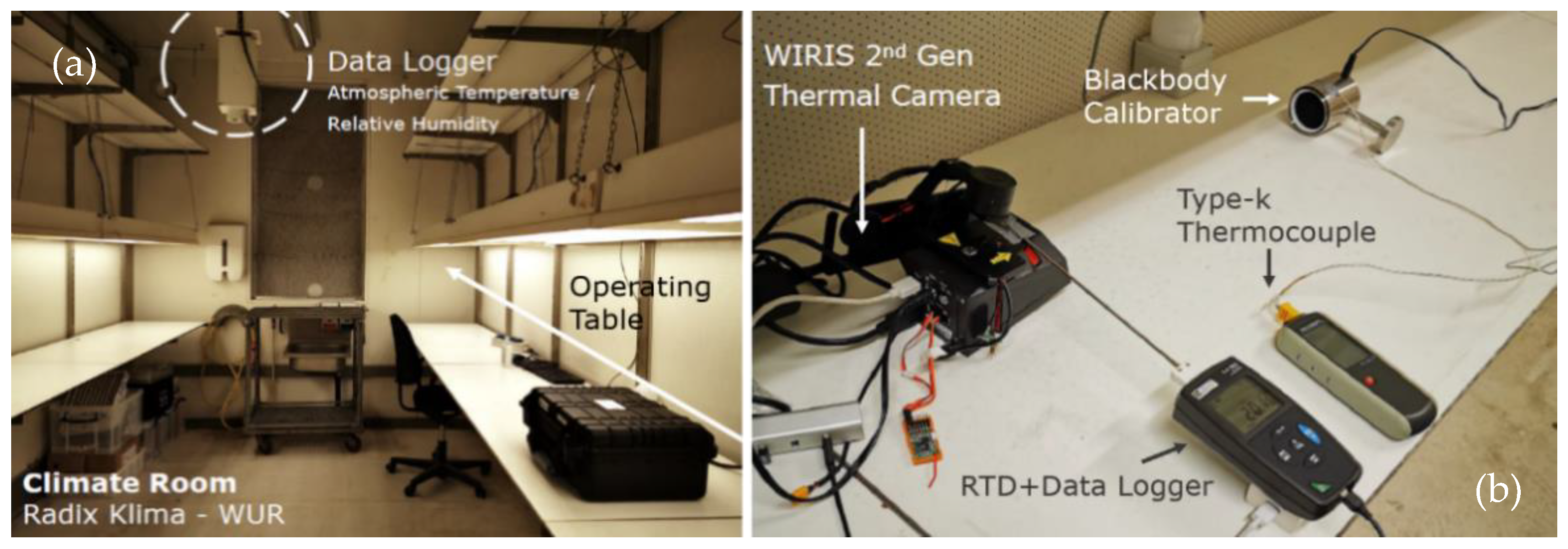



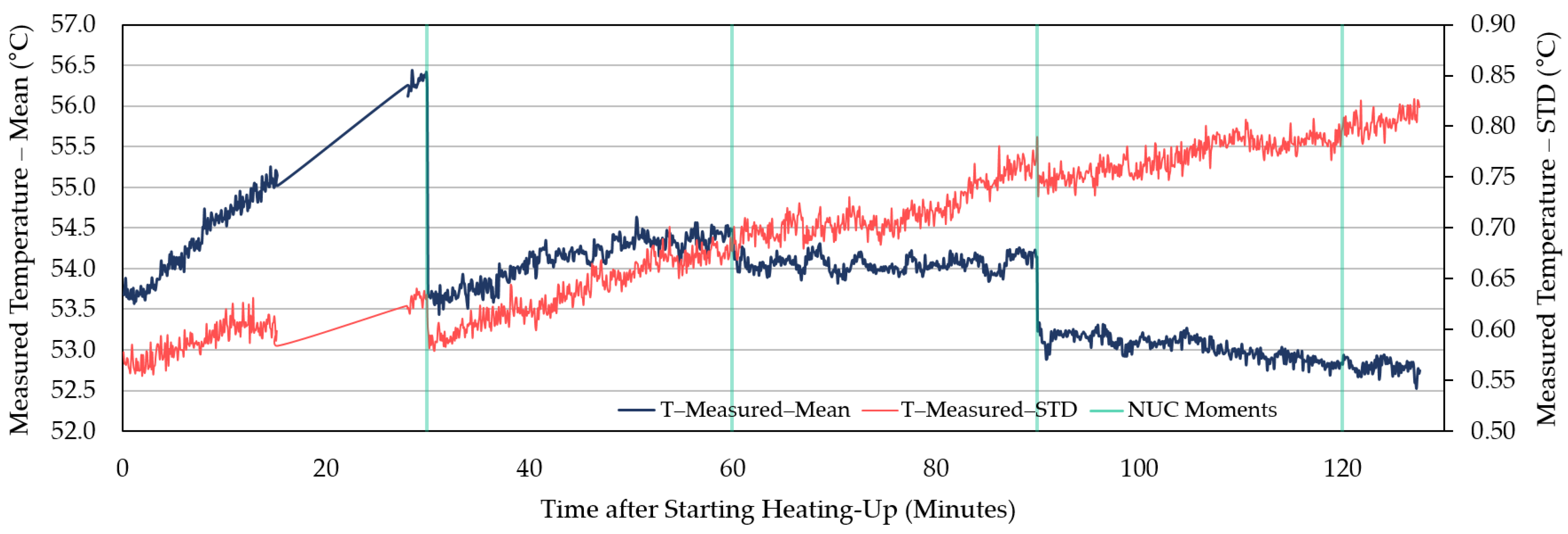


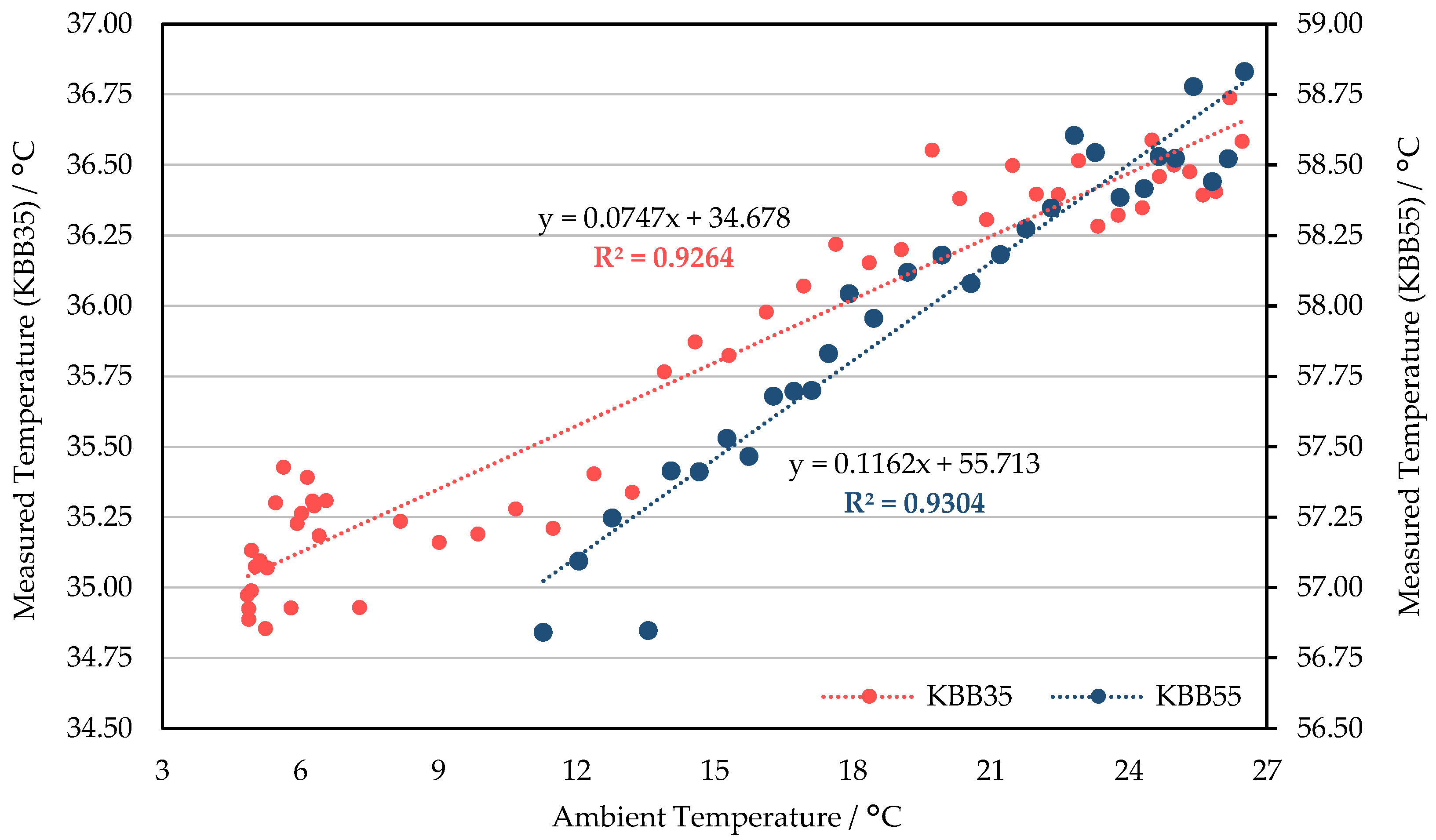
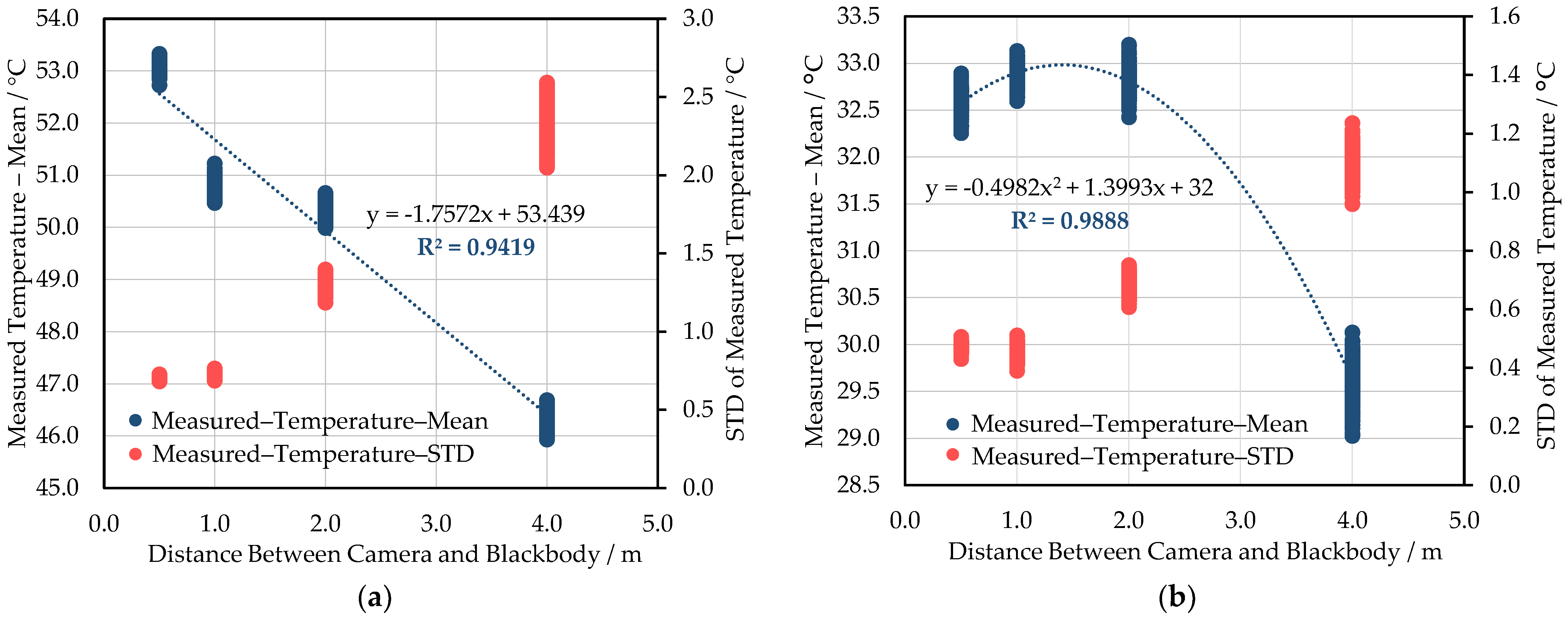
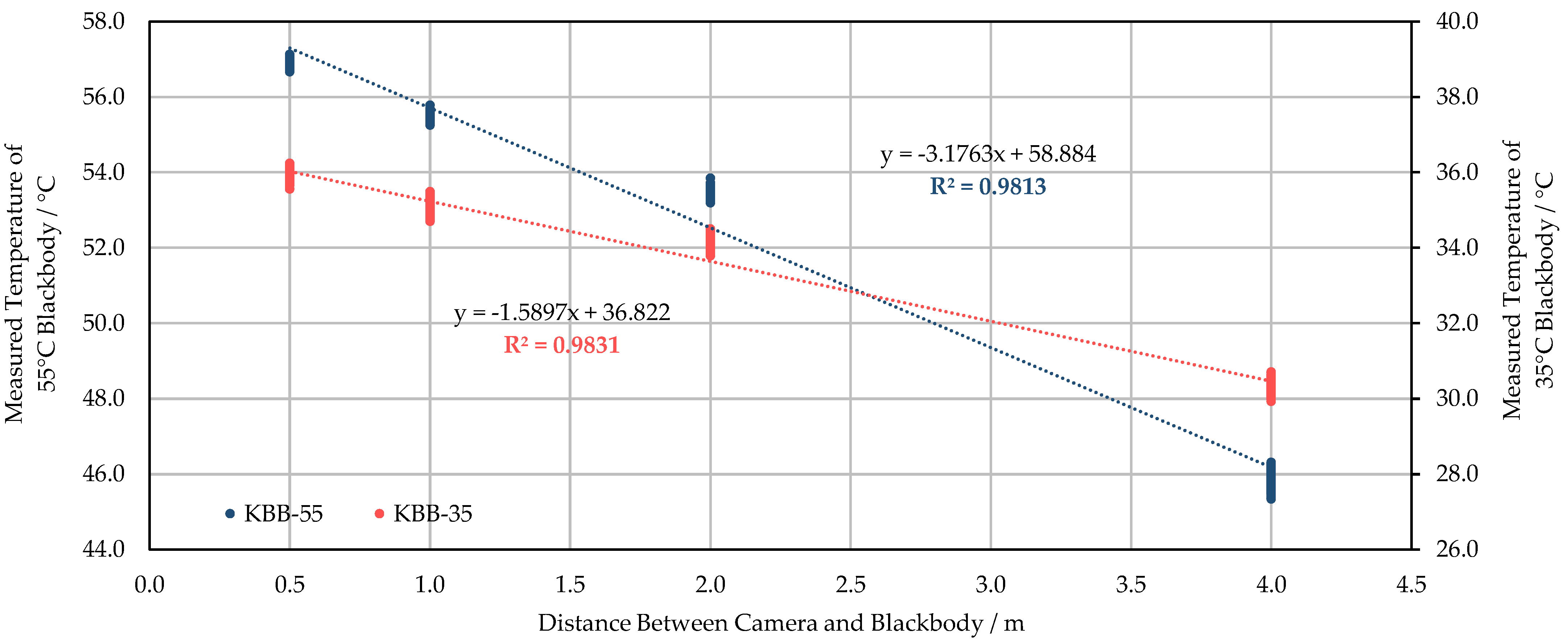

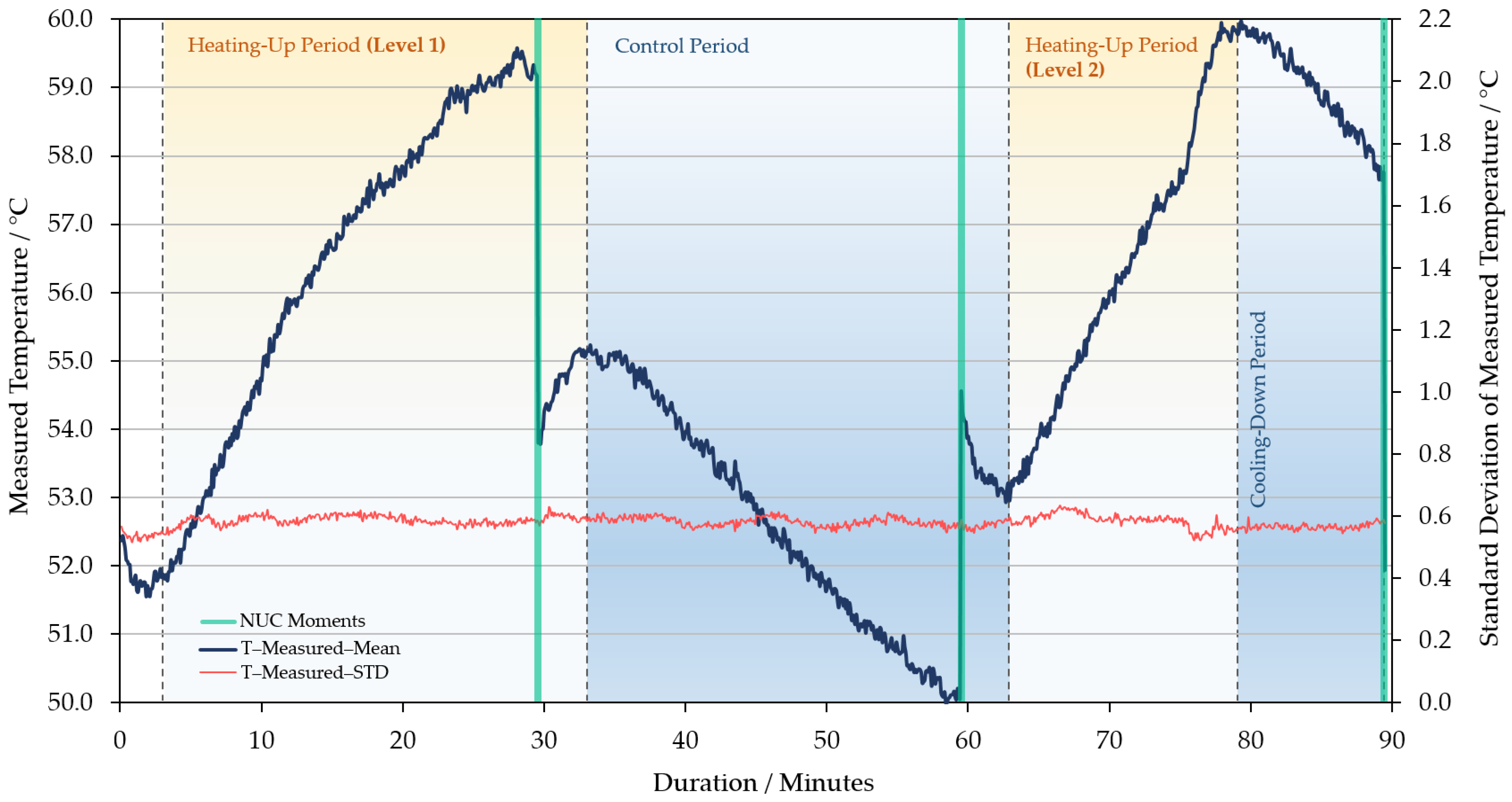
| Camera | Workswell WIRIS 2nd GEN | FLIR E8-XT |
|---|---|---|
| TIR Resolution | 640 × 512 pixels | 320 × 240 pixels |
| Field of View (FOV) | 69° × 56° (focal length = 9 mm) | 45° × 34° |
| Active sensor size of focal plane array (FPA) | 1.088 × 0.8705 cm | - |
| Temperature ranges | −25 °C to +150 °C, −40 °C to +550 °C | −20 °C to +550 °C |
| Temperature sensitivity | 0.05 °C (50 mK) | < 0.05 °C (50 mK) |
| Accuracy | ±2 °C or ±2% of reading | ±2 °C or ±2% of reading, for ambient temperature 10 °C to 35 °C |
| Spectral Range | 7.5–13.5 μm | 7.5–13.0 μm |
| Calibration | Yes | |
| Detector type | FPA, uncooled vanadium oxide (VOx) microbolometer | |
| Experiment | TIR Camera | Measuring Distance | Capture Time Interval /Total Time | Time Interval of Non-Uniformity Corrections (NUCs) | Atmospheric Temperature (Ta) | Relative Humidity (RH) |
|---|---|---|---|---|---|---|
| a. Stabilization time | WIRIS | 0.5 m | 5 s/2–3 h | 2 and 30 min | 15 °C | 70% |
| FLIR E8-XT | 5 s/1 h | turned off | ||||
| b. Ambient temperature’s influence | WIRIS | 0.2 m | 30 s/ 6–19.5 h | 30 min | Setting points: 5 °C, 10 °C, 14 °C, 18 °C, 20 °C, 22 °C, 25 °C; the actual temperature change is continuous, approximately from 5 °C to 25 °C | |
| FLIR E8-XT | 30 s/5.5 h | turned off | ||||
| c. Distance’s influence | WIRIS | 0.5 m, 1.0 m, 2.0 m, 4.0 m | 5 s/80 min | 30 min | 15 °C | |
| FLIR E8-XT | turned off | |||||
| d. Wind and heating-up effects | WIRIS | 0.5 m | 5–10 s /2–3 h | 30 min |
Publisher’s Note: MDPI stays neutral with regard to jurisdictional claims in published maps and institutional affiliations. |
© 2021 by the authors. Licensee MDPI, Basel, Switzerland. This article is an open access article distributed under the terms and conditions of the Creative Commons Attribution (CC BY) license (https://creativecommons.org/licenses/by/4.0/).
Share and Cite
Wan, Q.; Brede, B.; Smigaj, M.; Kooistra, L. Factors Influencing Temperature Measurements from Miniaturized Thermal Infrared (TIR) Cameras: A Laboratory-Based Approach. Sensors 2021, 21, 8466. https://doi.org/10.3390/s21248466
Wan Q, Brede B, Smigaj M, Kooistra L. Factors Influencing Temperature Measurements from Miniaturized Thermal Infrared (TIR) Cameras: A Laboratory-Based Approach. Sensors. 2021; 21(24):8466. https://doi.org/10.3390/s21248466
Chicago/Turabian StyleWan, Quanxing, Benjamin Brede, Magdalena Smigaj, and Lammert Kooistra. 2021. "Factors Influencing Temperature Measurements from Miniaturized Thermal Infrared (TIR) Cameras: A Laboratory-Based Approach" Sensors 21, no. 24: 8466. https://doi.org/10.3390/s21248466






